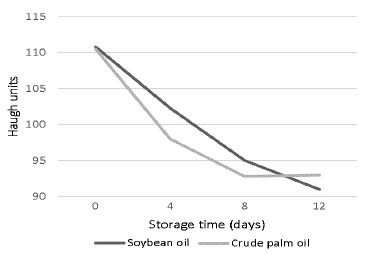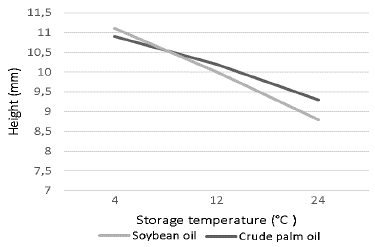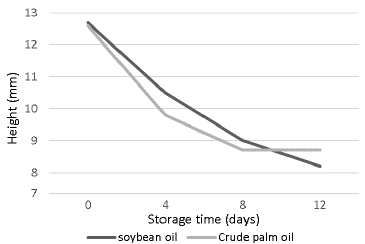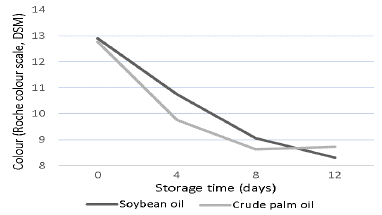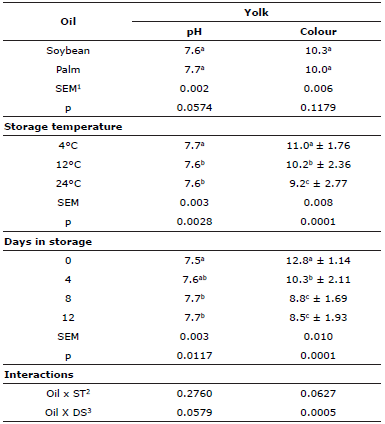Services on Demand
Journal
Article
Indicators
-
 Cited by SciELO
Cited by SciELO -
 Access statistics
Access statistics
Related links
-
 Cited by Google
Cited by Google -
 Similars in
SciELO
Similars in
SciELO -
 Similars in Google
Similars in Google
Share
Revista MVZ Córdoba
Print version ISSN 0122-0268On-line version ISSN 1909-0544
Rev.MVZ Cordoba vol.24 no.3 Córdoba Sep./Dec. 2019 Epub June 01, 2020
https://doi.org/10.21897/rmvz.1244
Research article
Egg quality during storage of eggs from hens fed diets with crude palm oil
1 Universidad Autónoma de Yucatán (UADY), Facultad de Medicina Veterinaria y Zootecnia, Km 15.5 carr. Mérida - Xmatkuil, Mérida, Yucatán, México.
Objective.
Evaluate the effect of crude palm oil (CPO) on quality traits of eggs stored various days at different temperatures.
Material and Methods.
A total of 240 hens, 28 weeks of age were fed diets with 30 g/kg of soybean oil (SO) or CPO. After 12 weeks, sample of eggs were stored during 0, 4, 8 and 12 days at 4, 12 and 24 °C. Egg quality traits were evaluated.
Results.
Egg and albumen from hens in CPO diet were heavier than those in SO (p<0.05). High storage temperature reduced egg, albumen and yolk weights, Haugh units (HU), albumen and yolk heights, pH and color (p<0.05), but increased albumen and yolk widths and albumen length (p<0.05). As storage time increased, egg weight, albumen weight and height, and yolk height, pH and colour were reduced (p<0.05). However, yolk weight and width, albumen width and length increased (p<0.05). Oil x storage time interaction (p<0.05) indicated that albumen height, HU and yellowness of yolk from hens in CPO diets were better at 12 days of storage than for hens fed SO.
Conclusions.
Hens in CPO diet had heavier eggs and albumen than those in SO diet. Egg quality traits decreased as temperature and days of storage increased, but, eggs from hens supplemented CPO had better quality in some traits at 12 days of storage.
Keywords: Egg deterioration; egg properties; Elaeis guineensis; layer chickens; storage conditions (Sources: Agrovoc; CAB)
Objetivo.
Evaluar el efecto del aceite crudo de palma (ACP) sobre la calidad del huevo almacenado por varios días a diferentes temperaturas.
Materiales y métodos.
Un total de 240 gallinas de 28 semanas se alimentaron con dietas con 30g/kg de aceite de soya (AS) o ACP. Después de 12 semanas, muestras de huevos se almacenaron durante 0, 4, 8 y 12 días a 4, 12 y 24°C. Las características de calidad del huevo fueron evaluadas.
Resultados.
El huevo y la albúmina de gallinas en la dieta con ACP fueron más pesados que aquellos en la dieta con AS (p<0.05). La alta temperatura de almacenamiento redujo el peso del huevo, albúmina y yema, unidades Haugh (UH), altura de la albúmina y la yema, pH y color (p<0.05), pero aumentó el ancho de la albúmina y la yema, y la longitud de la albúmina (p<0.05). A medida que aumentaba el tiempo de almacenamiento, el peso del huevo, el peso y la altura de la albúmina, y la altura de la yema, el pH y el color se redujeron (p<0.05). Sin embargo, el peso y el ancho de la yema, el ancho y la longitud de la albúmina aumentaron (p<0.05). La interacción aceite x tiempo de almacenamiento (p<0.05) indico que la altura de la albumina, UH y el color de la yema de los huevos de la dieta con ACP fueron mejores a los 12 días de almacenamiento que en la dieta con AS.
Conclusiones.
Las gallinas en la dieta con ACP tuvieron huevos y albuminas más pesadas que las de las de la adieta con AS. La calidad del huevo disminuyó conforme el tiempo y temperatura de almacenamiento se incrementó, pero, los huevos de las gallinas suplementadas con ACP tuvieron mejor calidad en algunas características a los 12 días de almacenamiento.
Palabras clave: Condiciones de almacenamiento; deterioro del huevo; Elaeis guineensis; gallinas de postura; propiedades del huevo (Fuente: Agrovoc; CAB)
INTRODUCTION
In tropical regions, the ambient temperature commonly reaches more than 30°C. Those temperatures affect negatively the quality of eggs during storage. Because of storage time and temperature, eggs lost weight, albumen reduces height and length, vitelline membrane becomes weak and yolk gets flattened 1,2.
Storage of eggs at 4°C reduced significantly the egg weight loss 3,4,5. However, in tropical areas, eggs are exposed to warm temperatures during handling, transportation and distribution of eggs. Physical and chemical characteristics of eggs like albumen and yolk pH increased and thickness of albumen and yolk index reduced when eggs were stored at 25°C 2. Many physicochemical processes happen in the eggs when stored. Among them, can be mentioned an increase in trypsin activity in the albumen, that increases the liquefaction of the thick albumen portion 6; and an increase in pH in both albumen and yolk due to the release of carbon dioxide 1,2. To avoid this oxidative process, antioxidants are added to the hen’s diet. Natural antioxidants such as vitamin E or α-tocopherols have been studied, with good results 7,8.
Crude palm oil extracted from the fruits of the palm oil tree (Elaeis guinensis) consist mainly of unsaturated fatty acids (50%) and saturated fatty acids (50%) 9. Njoku and Nwazota 10 found that the inclusion of 50 g/kg palm oil increased egg production, egg weight, food intake and feed utilization. Furthermore, palm oil has a great content of vitamin E in form of α-tocopherols and tocotrienols that have shown reduction of oxidative process in the endothelial tissues 11,12,13,14. However, there is no information about the use of crude palm oil in hen diets and its effect on the quality of eggs during storage.
Therefore, the objective of the present study was to evaluate the effect of adding crude palm oil in diets of laying hens on egg quality traits of eggs stored various days at different temperatures.
MATERIAL AND METHODS
Animals and housing conditions. Two hundred and forty hens (Isa-Babcock B-300), 28 weeks of age that started production at 18 weeks, and reached peak of production at 28 weeks of age were used. The experimental period began after peak of production and lasted 12 weeks. The hens were randomly distributed in cages of 40 cm x 40 cm. Thirty cages with two hens by cage and twenty cages with three hens by cage in each treatment for a total of 50 cages (experimental unit) were used. There were 50 replicates by source of vegetable oil evaluated. The cages had individual feeders of 400 g capacity.
Experimental diets. A basal diet was designed according to the requirement for laying hens 15, with 30 g/kg of crude palm oil (CPO) or soybean oil (SO) depending of the treatment (Table 1). The basal diet was composed of sorghum and soybean meal. The birds had free access to feed and water throughout the experiment. The feeders were fill every day to kept ad libitum feeding condition. Average feed intake was calculated every week as difference of feed offered and refused, between birds in each cage. The average feed intake recorded during the experimental period were 100.8±7.8 and 101.2±8.2 g for SO and CPO diets respectively.
Table 1 Ingredients and chemical composition of the basal diets.

1Vitamin and mineral premix: Mn, 65 mg; I, 1 mg; Fe, 55 mg, Cu, 6 mg; Zn, 55 mg; Se, 0.3 mg; vitamin A, 8000 UI; vitamin D, 2500 UI; vitamin E, 8 UI; vitamin K, 2 mg; vitamin B12, 0.002 mg; Riboflavin, 5.5 mg; Calcium pantothenate 13 mg; Niacine, 36 mg; Choline chloride, 500 mg; Folic acid, 0.5 mg; Thiamine, 1 mg; Pyridoxine, 2.2 mg; Biotin, 0.05 mg.
Storage time and temperature. After twelve weeks of feeding, one egg of each cage was randomly collected, during four consecutive days. The collected eggs were assigned to four storage times (0, 4, 8 and 12 days) and three storage temperatures (4, 12 and 24°C). Therefore, there were 12 treatment combinations of storage time and storage temperature. The eggs at 4°C were stored in a refrigerator. The eggs at 12 and 24°C were stored in rooms with air conditioners calibrated to the corresponded experimental temperature. After the storage time assigned, eggs were weighed (scale of 0.1 g, Ohaus CS 200), broken carefully and the content (yolk and albumen) was smoothly deposited on a flat plate. The length and width of albumen and yolk were measured with a vernier (Vernier calibrator 150 mm, Surtek company) and the height with a micrometric screw (Digital micrometer 25 mm, Syntek). Then, the yolk and the albumen of each egg were weighed. Yolk colour was evaluated visually with a Roche yolk colour fan with 15 colour gradation (DSM company, animal nutrition and health). The pH in yolk was measured with a portal pH meter (Oakton, ecotester).
Haugh Unit (HU) was calculated using the formula of Eke et al (1):
HU = 100 log (AH + 7.57 - 1.7W0.37)
Where:
HU = Haugh unit
AH = Albumen height (mm)
W = Egg weight (g)
Statistical analysis. The effect of oil source, storage time and temperature on egg traits was evaluated using a split plot design; where source of oil was the main plot, and temperature and time of egg storage levels combination was the sub-plots. Source of oil effect was tested using as experimental error, replicates within oil sources mean squares. The effect of temperature, time of storage, source of oil x temperature, source of oil x storage time and temperature x time was tested with the residual mean squares. Temperature and time mean comparison where made using Tukey tests. All statistical analysis was carried out using the GLM procedure of SAS 16.
RESULTS
Egg quality trait and Haugh units. As it is shown in table 2, eggs and albumen of laying hens fed diets with CPO weighed more than those from hens fed SO (p<0.05). However, there was no effect of oil source on egg yolk weight and HU (p>0.05).
Table 2 Effect of source of oil in the diet, storage temperature and days in storage on weight of eggs, albumen, yolk and Hugh units.
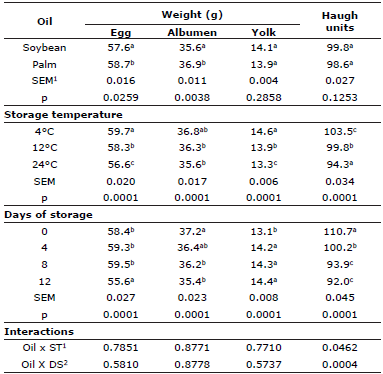
1 Standard error of the mean; 2 ST=Storage temperature; 3 DS=Days in storage
Means in the same column with different superscripts differ significantly (p<0.05)
Temperature of storage reduced significantly the weights of egg, albumen and yolk, as well as HU (p<0.05). The heaviest eggs, albumens and yolks were found in eggs stored at 4°C, and the lowest in eggs stored at 24°C. Haugh units shows a significant interaction of oil source x storage temperature (p<0.05). This interaction denotes that eggs from laying hens fed diets with CPO had lower HU than hens fed diets with SO (Figure 1).
Days in storage affected negatively the weights of eggs and albumen (p<0.05). As days in storage increased, the weights of eggs and albumen was reduced, whereas, yolk weight increased conforming days of storage increased (p<0.05). Significant interaction of oil source x storage time for HU was found (p<0.05). This interaction denotes that HU of eggs from hens fed diets with CPO was higher after 12 days of storage, in comparison to eggs from hens fed diets with SO.
Quality traits of albumen and yolk. The effects of source of oil in the diet, storage time and temperature on albumen and yolk traits are shown in table 3. The oil source in the diet did not affect any of the traits measured in the albumen or the yolk (p>0.05). However, an effect of storage temperature was found (p<0.05). Albumen width and length and yolk width increased as storage temperature increased from 4 to 24°C (p<0.05), but, albumen and yolk height was reduced (p<0.05).
Table 3 Effect of source of oil in the diet, storage temperature and storage period on albumen and yolk measurements.
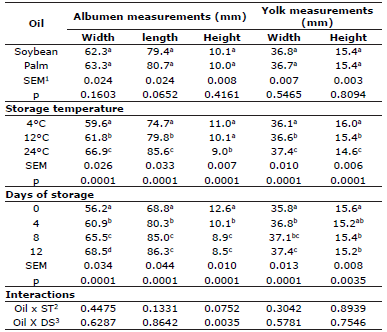
1 Standard error of the mean; 2 ST=Storage temperature; 3 DS=Days in storage
Means in the same column with different superscripts differ significantly (p<0.05)
An increase in width and length of the albumen was observed as the days of storage increased (p<0.05). Similar results were observed for yolk width (p<0.05). In contrast, albumen and yolk height decreased as storage temperature increased from 4 to 24°C (p<0.05). However, it is necessary to point out, the significant interactions of oil source x storage temperature and oil source x storage time (p<0.05) (Figura 2). Those interactions indicate that albumen height of eggs from hens fed diets with CPO declined more as storage temperature increased, in comparison to the albumen from eggs of hens fed diets with SO (Figure 3). However, albumen height of eggs from hens fed diets with CPO was highest at day 12 of storage than those from hens fed diets with SO (Figure 4).
Yolk pH and colour. The effect of oil source in the diet of laying hens, storage time and temperature on pH and colour of yolk are shown in table 4. There was no significant effect of oil source on yolk pH and colour (p>0.05). Increases of storage temperature produced a reduction of yolk pH and colour, as storage temperature increased (p<0.05). The pH of the yolk rise and the color of the yolk deteriorated considerably from 12.8 at day 0 to 8.5 after 12 days of storage (p<0.05). Significant interaction of oil source x storage time, denote that yellowness of yolk in hens fed diets with CPO was higher than for hens in diets with SO at day 12 of storage (Figure 5).
DISCUSSION
Egg quality traits and Haugh units. The highest egg weight and albumen found in this work in hens fed CPO diets, compared to those fed SO (Table 2) coincide with Njoku and Nwazota 10 who found that hens fed diets with palm oil had heavier eggs in comparison to those fed diets with SO. In other research report no differences between using soybean or palm oil in the diet were observed on egg weight 17. Although, CPO have 50% of saturated fatty acids 9, which have low metabolizable energy value in poultry 18, there is evidence that mixing saturated and unsaturated fatty acids in the diet of poultry improve metabolizable energy value 18,19. Then, CPO that have a natural mixture of satured and unsatured fatty acids, can be used in laying hen diets to improve egg weight and albumen, as was observed in this experiment.
Reduction in egg, albumen and yolk weight conforming storage temperature increased from 4 to 24°C, observed in this experiment agree with previous reports 1,2. The reductions in weight have been associated to increase in moisture losses from the eggs as storage temperature increases 20,21,22. Similarly, when storage time is lengthened, moisture losses from the eggs increase 21,23. The moisture loss contributes to losses in egg and albumen weights as observed in this experiment (Table 3). However, in this experiment, conforming days of storage increased, yolk weight increased 10% (Table 3). This effect has been reported before and it is related to material and water from albumen that passed through the yolk, because of weakening of the vitelline membrane, as storage time increases 24,25.
Significant interaction of oil source x storage temperature and oil x storage time (p<0.05) suggest that supplementation in the diet of hens with SO kept higher HU than CPO at different storage temperatures, but, use of CPO had higher HU than SO when storage time was extended (Figure 2). These finding could be related to content of vitamin E reported for CPO that can reduce oxidative process 12,13,14, mainly when storage time is lengthened. Those results make sense, because lipo-soluble vitamins, like vitamin E, denaturalized easily at warm temperatures. Therefore, if eggs are stored at room temperature, the antioxidant effects of the CPO could not be observed, but, if eggs are stored at 4°C, egg quality could be preserved for longer time.
Quality traits of albumen and yolk. Albumen and yolk width and height, and albumen length were affected by storage temperature. The reduction in albumen height was inversely correlated to increases in albumen width and length, conforming storage temperature increased (Table 3). These results agree with other reports 25,26,27,28. During storage, the gelatinous structure of the thick albumen gradually liquefies, making it thinner 23,29. As it happens in albumen, the height of yolk was reduced and width increased as storage temperature increased (Table 3). It has been reported that an increase in storage temperature reduces the yolk strength of vitelline membrane, which results in widening and flattening of yolk 30,31.
Similar effects occur with storage time; as the days in storage increased, the vitelline membrane strength of the yolk was reduced and became wider and flatter 31. The increase in storage time, increased progressively, the weakening of the vitelline membrane and liquefaction of the yolk, caused mainly by water diffusion from the albumen, which results in a widening and flattening of the yolk 22,25,29.
Significant interactions of oil source x storage temperature and oil source x storage time for albumen height (Figures 3 and 4), shows that albumen was highest in eggs of hens supplemented with SO at 24°C than those given CPO. However, albumen stored 12 days was highest in eggs of hens supplemented CPO in comparison to those supplemented SO. As mentioned above, the effect of CPO was not observed when the storage temperature was 24°C, because of the oxidative role of vitamin E, but, after 12 days of storage and when temperatures were not so high, the quality of albumin last longer.
Yolk pH and colour. Eggs recently laid have an initial albumen pH of 7.4 to 8.6, and are CO2 satured. In this experiment pH increased as temperature rise from 4 to 24°C and storage time lengthens (Table 4). Those results agree with previous reports 22,23,27. The increase in albumen pH is associated to loss of CO2 via eggshell pores 22,23,27.
Reduction in yolk colour, observed in this experiment, as storage time and temperature increased (Table 4), have been reported previously 22. Yolk colour is chiefly dependent upon the content of yolk carotenoids, which can be degraded by oxidative processes, varying the yolk pigmentation during storage 22. Diffusion of water from albumen to the yolk with longer storage time and high storage temperature, accelerate oxidative process of yolk pigment 22,30.
The significant interaction of oil source x storage time for yolk colour, suggest that yolk from eggs of hens fed diets supplemented with CPO held a better yellow colour than yolk from eggs of hens supplemented with SO, when storage was for longer time. These finding suggest that probably vitamin E from CPO could reduce oxidative process and preserve yolk color during more time 12,13,14.
In conclusion eggs and albumen from hens given CPO in the diet were heavier than those given SO. The increase of storage temperatures from 4 to 24°C and time of storage from 0 to 12 days reduced egg, albumen and yolk weights. In general, egg quality deteriorates as both storage time and temperature increased. However, interactions observed here, suggest that CPO supplementation of laying hens kept egg quality characteristics, like HU, albumen height and yolk color, when storage last longer (12 days).
REFERENCES
1. Eke MO, Olaitan NI, Ochefu JH. Effect of storage conditions on the quality attributes of shell (table) eggs. Nig Food J. 2013; 31(2):18-24. https://doi.org/10.1016/S0189-7241(15)30072-2 [ Links ]
2. Yu-Chi L, Ter-Hsin C, Ying-Chen W, Yi-Chain L, Fa-Jui T. Effects of egg washing and storage temperature on the quality of eggshell cuticle and eggs. Food Chem. 2016; 211:687-693. https://doi.org/10.1016/j.foodchem.2016.05.056 [ Links ]
3. Shin D, Narciso-Gaytán C, Regenstein JM, Sánchez-Plata MX. Effect of various refrigeration temperatures on quality of shell eggs. J Sci Food Agric. 2012; 92(7):1341-1345. https://doi.org/10.1002/jsfa.4699 [ Links ]
4. Sert D, Aygun A, Demir MK. Effects of ultrasonic treatment and storage temperature on egg quality. Poult Sci. 2011; 90(4):869-875. https://doi.org/10.3382/ps.2010-00799 [ Links ]
5. Jones DR, Ward GE, Regmi P, Karcher DM. Impact of egg handling and conditions during extended storage on egg quality. Poul Sci. 2018; 97(2):716-723. https://doi.org/10.3382/ps/pex351 [ Links ]
6. Quan TH, Benjakul S. Quality, protease inhibitor and gelling property of duck egg albumen as affected by storage conditions. J Food Sci Technol. 2018; 55(2):513522. https://doi.org/10.1007/s13197-017-2960-6 [ Links ]
7. Cherian G, Traber MG, Goeger MP, Leonard SW. Conjugated linoleic acid and fish oil in laying hen diets: effects on egg fatty acids, thiobarbituric acid reactive substances, and tocopherols during storage. Poult Sci . 2007; 86(5):953958. https://doi.org/10.1093/ps/86.5.953 [ Links ]
8. Botsoglou E, Govaris A, Fletouris D, Iliadis S. Olive leaves (Olea europea L.) and αtocopheryl acetate as feed antioxidants for improving the oxidative stability of αlinolenic acid enriched eggs . J Anim Physiol Anim Nutr (Berl). 2013; 97(4):740753. https://doi.org/10.1111/j.1439-0396.2012.01316.x [ Links ]
9. Prada F, Ayala-Diaz IM, Delgado W, Ruiz-Romero R, Romero HM. Effect of fruit ripening on content and chemical composition of oil from three oil palm cultivars (Elaeis guineensis jacq.) grown in colombia. J Agric Food Chem. 2011; 59(18):10136-10142. https://doi.org/10.1021/jf201999d [ Links ]
10. Njoku PC, Nwazota AOU. Effect of dietary inclusion of ascorbic acid and palm oil on the performance of laying hens in a hot tropical environment. Br Poult Sci . 1989; 30(4):831-840. https://doi.org/10.1080/00071668908417209. [ Links ]
11. Choo YM, Ma AN, Chuah CH, Khor HT, Bong SC. A developmental study on the appearance of tocopherols and tocotrienols in developing palm mesocarp (Elaeis guineensis). Lipids. 2004; 39(6):561564. https://www.ncbi.nlm.nih.gov/pubmed/15554155 [ Links ]
12. Ali SF, Woodman OL. Tocotrienol Rich Palm Oil Extract Is More Effective Than Pure Tocotrienols at Improving Endothelium-Dependent Relaxation in the Presence of Oxidative Stress Oxidative. Medicine and Cellular Longevity 2015; 2015:150829. https://doi.org/10.1155/2015/150829 [ Links ]
13. Irías-Mata A, Stuetz W, Sus N, Hammann S, Gralla K, Cordero-Solano A, Vetter W, Frank J. Tocopherols, tocomonoenols, and tocotrienols in oils of costa rican palm fruits: a comparison between six varieties and chemical versus mechanical extraction. J Agric Food Chem . 2017; 65(34):7476-7482. https://doi.org/10.1021/acs.jafc.7b02230 [ Links ]
14. Ramanathan N, Tan E, Loh LJ, Seng Soh B, Ney Yap W. Tocotrienol is a cardioprotective agent against ageing-associated cardiovascular disease and its associated morbidities. Nutr Metab (Lond). 2018; 15:6. https://doi.org/10.1186/s12986-018-0244-4 [ Links ]
15. Santiago-Rostagno H. Tablas brasileñas para aves y cerdos, composición de alimentos y requerimientos nutricionales. 3era edición. Universidad Federal de Viçosa; Viçosa, Brasil: 2011. http://www.lisina.com.br/arquivos/Geral%20Espa%C3%B1ol.pdf [ Links ]
16. SAS. SAS / STAT Version 9.3. 4th ed. Cary: SAS Institute; 2010. [ Links ]
17. Kehui O, Wenjun W, Mingshen X, Yan J, Xinchen S. Effects of Different Oils on the Production Performances and Polyunsaturated Fatty Acids and Cholesterol Level of Yolk in Hens. Asian-Aust J Anim. Sci. 2004; 17(6):843-847. https://doi.org/10.5713/ajas.2004.843 [ Links ]
18. Murugesan GR, Kerr BJ, Persia ME. Energy content of select dietary supplemental lipids for broilers, turkeys, and laying hen. J Appl Poult Res. 2017; 26(4):536-547. https://doi.org/10.3382/japr/pfx027 [ Links ]
19. Khatun J, Loh TC, Akit H, Foo HL, Mohamad R. Fatty acid composition, fat deposition, lipogenic gene expression and performance of broiler fed diet supplemented with different sources of oil. Anim Sci J. 2017; 88(9):1406-1413. https://doi.org/10.1111/asj.12775 [ Links ]
20. Ragni L, Al-Shami A, Mikhaylenko G, Tang J. Dielectric characterization of hen eggs during storage. J Food Eng. 2007; 82(4):450-459. https://doi.org/10.1016/j.jfoodeng.2007.02.063 [ Links ]
21. Gómez-de-Travecedo P, Caravaca FP, González-Redondo P. Effects of storage temperature and length of the storage period on hatchability and performance of red-legged partridge (Alectoris rufa) eggs. Poult Sci . 2014; 93(3):747-754. https://doi.org/10.3382/ps.2013-03329 [ Links ]
22. Suresh PV, Raj KR, Nidheesh T, Pal GK, Sakhare PZ. Application of chitosan for improvement of quality and shelf life of table eggs under tropical room conditions. J Food Sci Technol . 2015; 52(10):6345-6354. https://doi.org/10.1007/s13197-015-1721-7 [ Links ]
23. Caner C, Yüceer M. Efficacy of various protein-based coating on enhancing the shelf life of fresh eggs during storage. Poult Sci . 2015; 94(7):1665-1677. https://doi.org/10.3382/ps/pev102 [ Links ]
24. Silversides FG, Scott TA. Effect of storage and layer age on quality of eggs from two lines of hens. Poult Sci . 2001; 80(8):1240245. https://doi.org/10.1093/ps/80.8.1240 [ Links ]
25. Jones DR, Karcher DM, Abdo Z. Effect of a commercial housing system on egg quality during extended storage. Poult Sci . 2014; 93(5):1282-1288. https://doi.org/10.3382/ps.2013-03631 [ Links ]
26. Jones DR, Musgrove MT. Effects of extended storage on egg quality factors. Poult Sci . 2005; 84(11):1774-1777. https://doi.org/10.1093/ps/84.11.1774 [ Links ]
27. Biladeau AM, Keener KM. The effects of edible coatings on chicken egg quality under refrigerated storage. Poult Sci . 2009; 88(6):1266-1274. https://doi.org/10.3382/ps.2008-00295 [ Links ]
28. Günhan S, Kirikçi K. Effects of different storage time on hatching results and some egg quality characteristics of rock partridge (A. graeca) (management and production). Poult Sci . 2017; 96(6):16281634. https://doi.org/10.3382/ps/pew443 [ Links ]
29. Nongtaodum S, Jangchud A, Jangchud K, Dhamvithee P, No HK, Prinyawiwatkul W. Oil coating affects internal quality and sensory acceptance of selected attributes of raw eggs during storage. J Food Sci. 2013; 78(2) S329-S335. https://doi.org/10.1111/1750-3841.12035 [ Links ]
30. Jin YH, Lee KT, Lee WI, Han YK. Effects of storage temperature and time on the quality of eggs from laying hens at peak production. Asian-Aust J Anim Sci. 2011; 24(2):279-284. https://doi.org/10.5713/ajas.2011.10210 [ Links ]
31. Torrico DD, No HK, Prinyawiwatkul W, Janes M, Corredor JAH, Osorio L.F. Mineral oil-chitosan emulsion coatings affect quality and shelf-life of coated eggs during refrigerated and room temperature storage. J Food Sci . 2011; 76(4):s262-s268. https://doi.org/10.1111/j.1750-3841.2011.02125.x [ Links ]
Como citar (Vancouver). Santos RR, Segura CJ, Sarmiento FL.Calidad durante el almacenamiento de huevos de gallinas alimentadas con dietas con aceite de palma. Rev MVZ Cordoba. 2019; 24(3):7297-7304. DOI: https://doi.org/10.21897/rmvz.1244
Received: June 2018; Accepted: March 2019; Published: August 2019











 text in
text in 


